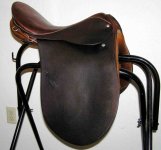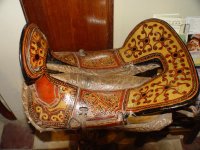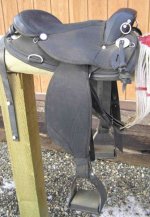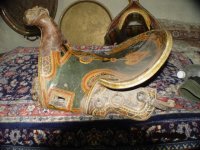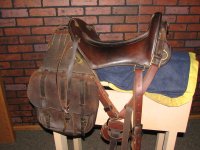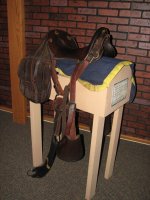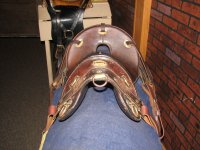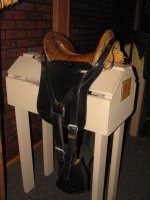♘امیرحسین♞
♘ مدیریت انجمن اسب ایران ♞
A saddle is a seat for a rider fastened to an animal's back. The most common type is the equestrian saddle designed for a horse, but specialized saddles have been created for camels and other creatures.
Types of modern equestrian saddle
In the Western world there are two basic types of saddles used today for horseback riding, usually called the English saddle and the "Stock" Saddle. The best known stock saddle is the American western saddle, followed by the Australian Stock Saddle. In Asia and throughout the world, there are numerous saddles of unique designs used by various nationalities and ethnic groups.
English saddle
English saddles are used for English riding throughout the world, not just in England or English-speaking countries. They are the saddles used in all of the Olympic equestrian disciplines. The term English saddle encompasses several different styles of saddle, including those used for eventing, show jumping and hunt seat, dressage, saddle seat, horse racing and polo.
To the casual observer, the major distinguishing feature of an English saddle is its flatter appearance, the lack of a horn, and the self-padding design of the panels: a pair of pads attached to the underside of the seat and filled with wool, foam, or air. However, the length and angle of the flaps, the depth of the seat and height of the cantle all play a role in the use for which a particular saddle is intended.
Although to the untrained eye all saddles of a similar design look alike, the "tree" that underlies the saddle is usually one of the defining features of saddle quality. Traditionally, the tree of an English saddle is built of laminated layers of high quality wood reinforced with spring steel along its length, with a riveted gullet plate. These trees are semi-adjustable and are considered "spring trees." They have some give, but a minimum amount of flexibility.
Stock saddles
Western saddles are saddles originally designed to be used on horses on working cattle ranches in the United States. Used today in a wide variety of western riding activities, they are the "cowboy saddles" familiar to movie viewers, rodeo fans, and those who have gone on tourist trail rides. The Western saddle has no padding of its own, and must be used with a saddle blanket or pad in order to provide a comfortable fit for the horse. It also has sturdier stirrups and uses a cinch rather than a girth. Its most distinctive feature is the horn on the front of the saddle, originally used to dally a lariat when roping cattle.
Other nations such as Australia and Argentina have stock saddles that lack a horn but have other features commonly seen in a western saddle, including a deep seat, high cantle, and heavier leather.
The tree of a western saddle is the most critical component, defining the size and shape of the finished product. The tree determines both the width and length of the saddle as it sits on the back of the horse, as well as the length of the seat for the rider, width of the swells (pommel), height of cantle, and, usually, shape of the horn. Traditional trees were made of wood or wood laminate covered with rawhide, though modern synthetic materials are also used today. Leather is stretched and molded around the tree, with minimal padding between the tree and the exterior leather, usually a bit of relatively thin padding on the seat, and a sheepskin cover on the underside of the skirts to prevent chafing and rubbing on the horse.
Though a western saddle is often considerably heavier than an English saddle, the tree is designed to spread out the weight of the rider and any equipment the rider may be carrying so that there are fewer pounds per square inch on the horse's back and, when properly fitted, few if any pressure points. Thus, the design, in spite of its weight, can be used for many hours with relatively little discomfort to a properly conditioned horse and rider.
Asian saddle
Saddles in Asia date back several thousand years to the time of the Scythians. Modern Asian saddles can be divided into two groups: Saddles from Central Asia, which have a prominent horn and leather covering, and saddles from East Asia, which have a high pommel and cantle. Central Asian saddles are noted for their wide seats and high horns. The saddle has a base of wood with a thin leather covering that frequently has a lacquer finish. Central Asian saddles have no pad and must be ridden with a saddle blanket. The horn comes in particular good use during the rough horseback sport of ‘‘buskashi (see Pashtun culture), played throughout Central Asia, which involves two teams of riders wrestling over a decapitated goat’s carcass.
Saddles from East Asia differ from Central Asian saddles by their high pommel and cantle and lack of a horn. East Asian saddles can be divided into several types that are associated with certain nationalities and ethnic groups. Saddles used by the Han Chinese are noted by their use of inlay work for ornamentation. Japanese saddles frequently are covered in a thick lacquer finish. Tibetan saddles typically employ iron covers inlaid with precious metals on the pommel and cantle and universally come with padding. Mongolian saddles are similar to the Tibetan style except that they are typically smaller and the seat has a high ridge. Saddles from ethnic minority groups in China’s southwest, such as in Sichuan and Yunnan provinces, have colorful lacquer work over a leather covering.
More recently, saddle manufacturers are using various materials to replace wood and create a synthetic molded tree, (some with the integrated spring steel and gullet plate, some without). Synthetic materials vary widely in quality. Polyurethane trees are often very well-made, but some very cheap saddles are made with fiberglass trees that are not terribly durable.
Synthetic trees are often lighter, more durable, and easier to customize. Some designs, such as the Schleese, are intended to be more flexible and move with the horse. Several companies also offer adjustable gullets that allow the same saddle to be used on different sizes of horses.
Types of modern equestrian saddle
In the Western world there are two basic types of saddles used today for horseback riding, usually called the English saddle and the "Stock" Saddle. The best known stock saddle is the American western saddle, followed by the Australian Stock Saddle. In Asia and throughout the world, there are numerous saddles of unique designs used by various nationalities and ethnic groups.
English saddle
English saddles are used for English riding throughout the world, not just in England or English-speaking countries. They are the saddles used in all of the Olympic equestrian disciplines. The term English saddle encompasses several different styles of saddle, including those used for eventing, show jumping and hunt seat, dressage, saddle seat, horse racing and polo.
To the casual observer, the major distinguishing feature of an English saddle is its flatter appearance, the lack of a horn, and the self-padding design of the panels: a pair of pads attached to the underside of the seat and filled with wool, foam, or air. However, the length and angle of the flaps, the depth of the seat and height of the cantle all play a role in the use for which a particular saddle is intended.
Although to the untrained eye all saddles of a similar design look alike, the "tree" that underlies the saddle is usually one of the defining features of saddle quality. Traditionally, the tree of an English saddle is built of laminated layers of high quality wood reinforced with spring steel along its length, with a riveted gullet plate. These trees are semi-adjustable and are considered "spring trees." They have some give, but a minimum amount of flexibility.
Stock saddles
Western saddles are saddles originally designed to be used on horses on working cattle ranches in the United States. Used today in a wide variety of western riding activities, they are the "cowboy saddles" familiar to movie viewers, rodeo fans, and those who have gone on tourist trail rides. The Western saddle has no padding of its own, and must be used with a saddle blanket or pad in order to provide a comfortable fit for the horse. It also has sturdier stirrups and uses a cinch rather than a girth. Its most distinctive feature is the horn on the front of the saddle, originally used to dally a lariat when roping cattle.
Other nations such as Australia and Argentina have stock saddles that lack a horn but have other features commonly seen in a western saddle, including a deep seat, high cantle, and heavier leather.
The tree of a western saddle is the most critical component, defining the size and shape of the finished product. The tree determines both the width and length of the saddle as it sits on the back of the horse, as well as the length of the seat for the rider, width of the swells (pommel), height of cantle, and, usually, shape of the horn. Traditional trees were made of wood or wood laminate covered with rawhide, though modern synthetic materials are also used today. Leather is stretched and molded around the tree, with minimal padding between the tree and the exterior leather, usually a bit of relatively thin padding on the seat, and a sheepskin cover on the underside of the skirts to prevent chafing and rubbing on the horse.
Though a western saddle is often considerably heavier than an English saddle, the tree is designed to spread out the weight of the rider and any equipment the rider may be carrying so that there are fewer pounds per square inch on the horse's back and, when properly fitted, few if any pressure points. Thus, the design, in spite of its weight, can be used for many hours with relatively little discomfort to a properly conditioned horse and rider.
Asian saddle
Saddles in Asia date back several thousand years to the time of the Scythians. Modern Asian saddles can be divided into two groups: Saddles from Central Asia, which have a prominent horn and leather covering, and saddles from East Asia, which have a high pommel and cantle. Central Asian saddles are noted for their wide seats and high horns. The saddle has a base of wood with a thin leather covering that frequently has a lacquer finish. Central Asian saddles have no pad and must be ridden with a saddle blanket. The horn comes in particular good use during the rough horseback sport of ‘‘buskashi (see Pashtun culture), played throughout Central Asia, which involves two teams of riders wrestling over a decapitated goat’s carcass.
Saddles from East Asia differ from Central Asian saddles by their high pommel and cantle and lack of a horn. East Asian saddles can be divided into several types that are associated with certain nationalities and ethnic groups. Saddles used by the Han Chinese are noted by their use of inlay work for ornamentation. Japanese saddles frequently are covered in a thick lacquer finish. Tibetan saddles typically employ iron covers inlaid with precious metals on the pommel and cantle and universally come with padding. Mongolian saddles are similar to the Tibetan style except that they are typically smaller and the seat has a high ridge. Saddles from ethnic minority groups in China’s southwest, such as in Sichuan and Yunnan provinces, have colorful lacquer work over a leather covering.
More recently, saddle manufacturers are using various materials to replace wood and create a synthetic molded tree, (some with the integrated spring steel and gullet plate, some without). Synthetic materials vary widely in quality. Polyurethane trees are often very well-made, but some very cheap saddles are made with fiberglass trees that are not terribly durable.
Synthetic trees are often lighter, more durable, and easier to customize. Some designs, such as the Schleese, are intended to be more flexible and move with the horse. Several companies also offer adjustable gullets that allow the same saddle to be used on different sizes of horses.

